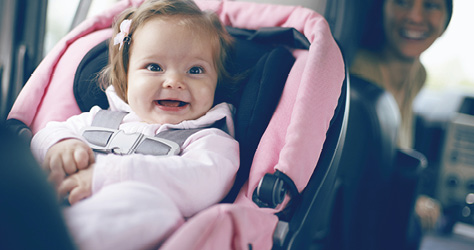Advice and tips on toddler car seat use and fitting.
From choosing and fitting your next car seat to dealing with unbuckling issues, let our guide prepare you for a smooth ride.
At a glance
- What car seat should you be using
- Fitting a car seat and ISOFIX
- Unbuckling and how to tackle it

Moving on up?
It used to be said that, if your baby weighs over 13kg or their head is higher than the top of their carrier it is likely to be time for a new rear-facing or forward-facing seat.
Rearward facing seats (Group 1 seats 1-4 years)
Research on rear-facing car seats for toddlers suggests children travelling rear-facing are much safer in the event of a crash.
Whilst you should keep your child in a rear-facing seat for as long as possible - forward-facing seats are not unsafe - but rearward facing ones give better protection in an impact.
Forward facing seats (Group 1 seats 1-4 years)
Most forward-facing seats are suitable for babies and toddlers between the weight of 9-18kgs (which usually encompasses an age range of anywhere from nine months to four years). However, these days with changing car seat laws more parents are opting to buy the safer rear facing seats right through to toddler age.
If your baby’s head is not higher than the top of their current rearward facing seat, keep them in there until they reach 13kg as this will offer them the most protection.
Fitting
Many newer cars have ‘ISOFIX’ points which (provided you buy the corresponding seat – check the manual or website) the car seat can simply be slotted onto.
Other are designed to be secured with the seatbelt. Most retailers selling car seats will have staff who are trained to show you how to fit the seat into your car. Not all seats fit into all cars so if possible take the car(s) you will be using the seat in on the day you go to buy it. Ask the staff to demonstrate for you and have a couple of attempts yourself. The trick is to fit the seat so that it doesn’t move around. You can do this by putting your weight into the seat whilst fitting it. It can become loose over time so make sure you regularly test and tighten it up.
The seatbelt fastening (the ‘clunk-click’ bit) shouldn’t be resting on the frame of the car seat. If it is this could be a sign that the seat is not fitted correctly. Contact your retailer or find out if there are any child seat checks taking place in your area.
Unbuckling…
If your toddler is a bit of a mini Houdini they may work out how to unbuckle their harness. There are various ways to deal with this. One is the old ‘we’re not going anywhere until you wear it’ routine. Another is to purchase a tamper-proof attachment designed for this problem. And a whole range of behavioural-development methods in between. As with all these things it’s about finding the approach that works best for you and your toddler but, as this could make all the difference in a collision, it is definitely an argument you need to win.
Ready for the next steps? Read all about safety for pre-schoolers.